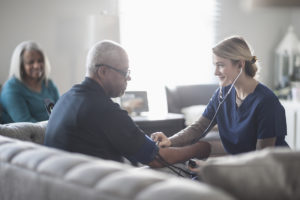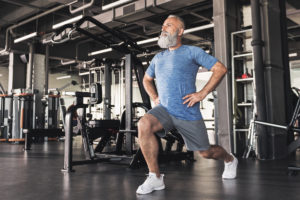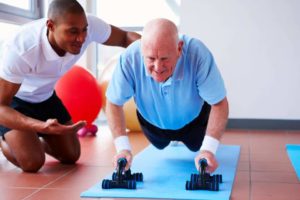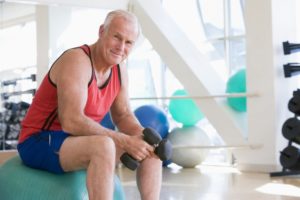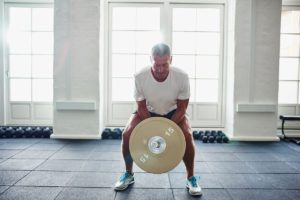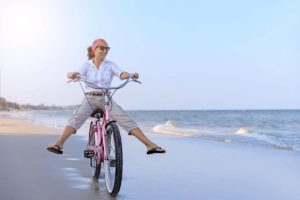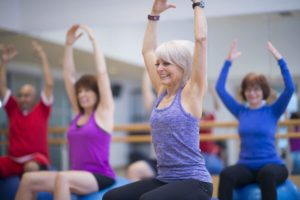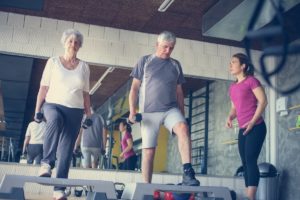Functional Aging/Older Adults
There Is Power in Protein for Older Adults
Many older adults could benefit from dropping a few pounds of body fat. With weight loss, though, there are often reductions in bone strength and lean body mass, thereby raising the risk of mobility issues and injury from falls. New research shows that a diet tweak might help older people retain their muscle while simultaneously scaling down their body fat.
Once-Weekly Strength Training for Older Adults
Great news for healthy older adults who may not be able to weight-train more than once a week. For 65- to 75-year-old men and women, supervised whole-body resistance training once weekly for 6 months led to significantly less inflammation, lower blood pressure and blood sugar levels, and better overall well-being.
Stop and Smell the Daisies
CLIENT: Brenda Badish
PERSONAL TRAINER: Kelly Fletcher
LOCATION: KFit Studios, Brighton, Michigan
Brenda Badish had almost given up hope that she could regain her health. “I figured I was a few weeks away from pushing up the daisies,” she says.
Gender Differences in Fitness and Brain Function
Many studies show that cardiorespiratory fitness improvements boost brain fitness in later life. New research in the Journal of Applied Physiology (2019; doi:10.1152/japplphysiol.01046.2018) reveals that effects may differ between men and women.
Blood Pressure, Diet and Aging
It’s official: The typical Western diet is a major driver of rising blood pressure as we age, not age itself as previously thought, according to research from the Johns Hopkins University Bloomberg School of Public Health published in JAMA Cardiology. The study revealed that members of the isolated South American Yanomami tribe, with virtually no Western dietary influences, typically have no rise in their blood pressure numbers from age 1 to age 60.
Eat Fish for a Long Life
If you want to enjoy many more birthdays in great health, it could be a good idea to cast your line for omega-3-rich fish more often. In a 13-year study of older Americans, published in the journal BMJ, those with higher circulating blood levels of marine-derived, long-chain omega-3 fatty acids—such as docosapentaenoic acid—were significantly more likely to age healthfully than their peers with lower levels of these omegs-3s in their blood.
The Power of Simple Lifestyle Changes
Lifestyle choices have a significant impact on quality and length of life. With many Americans living longer than ever, fitness pros are on the front lines of a complex challenge: How will we help people remain active and engaged from their 60s into their 90s and beyond? How can we help them stay healthy to rein in healthcare costs?
The Link Between “Tip-of-the-Tongue State” and Cardio Training
It might be time to motivate your senior clients to do more cardio. Evidence suggests that aerobic exercise can improve language skills by positively affecting brain regions associated with language processing. A recent study found that fitness and language skills are related, with cardiovascular fitness levels in healthy older adults directly linked to the ability to retrieve words hovering on the “tip of the tongue.”
Integrating Cognitive Training Into Exercise Programs for Older Adults
How can you “cognify” exercises to give your clients a big kick in the hippocampus? The basic ideas here can help you integrate cognitive stimuli into most exercises.
Inspiring Functionality
CLIENT: Erika Miller
PERSONAL TRAINER: Michele DeJesus, MS (movement therapy), PhD (nutrition)
LOCATION: Lexington Athletic Club, Lexington, Kentucky
Older Adult Fitness & Your Business
The aging of the global population is single-handedly forcing and inspiring change in many ways—both obvious and subtle. The continued growth of the older population for the next 30+ years will influence the fitness industry in ways that we probably can’t even imagine yet. To help you prepare for this growth, here are some noteworthy aging trends (counting down from least to most important from a business standpoint) that could affect you over the next 5–10 years.
Trend #5: Brain Fitness Comes of Age
Pilates and Fall Prevention
As many as one-third of all adults over 65 years old fall each year, with consequences that include serious injury, limited activity and significant costs. Researchers at California State University, Northridge, conducted a study that shows that Pilates reformer training—as little as once per week—can effectively reduce these risks.
Hormone Health and Functional Aging
Functional fitness is of particular importance when working with older adults, since aging is accompanied by a progressive decline in multiple physiological functions, including the ability to perform daily activities. The topic of “functional aging” addresses this ability (or lack thereof) and is becoming more and more relevant, given the increase in people 65 and older and the disability rates in this population.
Learn the endocrine system’s pivotal role in aging and how exercise can impact it.
5 Top Trends in Older-Adult Fitness
The aging of the global population is single-handedly forcing and inspiring change in many ways—both obvious and subtle. The continued growth of the older population for the next 30+ years will influence the fitness industry in ways that we probably can’t even imagine yet. To help you prepare for this growth, here are some noteworthy aging trends (counting down from least to most important from a business standpoint) that could affect you over the next 5–10 years.
Trend #5: Brain Fitness Comes of Age
Stay Strong to Increase Longevity
Here’s more motivation to stay on top of your functional strength training program. Researchers from China and Indiana University analyzed data from 4,449 older adults in the National Health and Nutrition Examination Survey and found that older people with low muscle strength had more than twice the risk of dying during the study than those with normal muscle strength.
Functional Aging and Hormone Health
Understanding functional aging and the impact of activity on hormones can arm fitness trainers to help clients with their active aging goals.
Functional Training for Active, Independent Living
Healthy aging is more than the absence of disease, according to the World Health Organization: “For most older people, the maintenance of functional ability has the highest importance” (WHO 2015).
Colin Milner, founder and CEO of the International Council on Active Aging in Vancouver, British Columbia, echoes that statement: “When looking at the healthy aging market today, the focus is all about function. The World Report on Ageing and Health (WHO 2015) focuses on function as a key element, because loss of functional abilities significantly impacts life quality. Having a chronic health issue, like diabetes or high blood pressure, is manageable, but if I can’t stand up, everything changes.”
A Defense Against Age-Related Slowing
Age-related slowing of movement plays a critical role in the declining health of older adults. Slowing typically begins after age 62 with a marked decrease in gait velocity. It can lead to dysfunction, poor mental and physical health, a loss of independence and higher risk of mortality.
The Optimal Amount of Exercise for Heart Health
Arterial stiffness, which increases with sedentary living, is associated with higher risk of heart disease. It’s well known that exercise can help, but how much—or how little—is enough?
“While near-daily, vigorous lifelong (>25 years) endurance exercise training prevents arterial stiffening with ageing, this rigorous routine of exercise training over a lifetime is impractical for most individuals,” noted the authors of a new study, which aimed to determine the least amount of exercise necessary to reduce arterial stiffness.
Exercise Doesn’t Slow Dementia, Say Researchers
Research has supported exercise as having the potential to keep dementia at bay or at least to impede its progression. A recent study suggests that physical activity may not be as effective at warding off cognitive decline as previously thought.
In this study, published in BMJ (2018; 361, k1675), 329 individuals were assigned to an exercise intervention, while 165 subjects received “usual care.” Average age was 77, and each participant had a clinically confirmed dementia diagnosis.




